

Anglo-Saxon literature: Prose. Old English literary prose dates from the latter part of the Anglo-Saxon period.

Prose was written in Latin before the reign of King Alfred (reigned 871–99), who worked to revitalize English culture after the devastating Danish invasions ended. As hardly anyone could read Latin, Alfred translated or had translated the most important Latin texts. He also encouraged writing in the vernacular. Didactic, devotional, and informative prose was written, and the Anglo-Saxon Chronicle, probably begun in Alfred's time as an historical record, continued for over three centuries.
Two preeminent Old English prose writers were Ælfric, Abbot of Eynsham, and his contemporary Wulfstan, archbishop of York. A great deal of Latin prose and poetry was written during the Anglo-Saxon period. The Columbia Electronic Encyclopedia, 6th ed. See more Encyclopedia articles on: English Literature to 1499. Edurete.org. The most important formal aspects of Anglo-Saxons poetry were stress and allitteration.
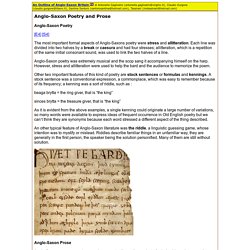
Each line was divided into two halves by a break or caesura and had four stresses; allitteration, which is a repetition of the same initial consonant sound, was used to link the two halves of a line. Anglo-Saxon poetry was extremely musical and the scop sang it accompanying himself on the harp. However, stress and allitteration were used to help the bard and the audience to memorize the poem. Other two important features of this kind of poetry are stock sentences or formulas and kennings. A stock sentence was a conventional expression, a commonplace, which was easy to remember because of its frequency; a kenning was a sort of riddle, such as :
An Examination of Anglo-Saxon lyric poetry by Colleen Klees. The Old English, or Anglo-Saxon, era of England lasted from about 450-1066 A.D.
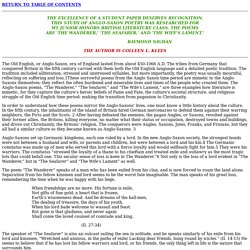
The tribes from Germany that conquered Britain in the fifth century carried with them both the Old English language and a detailed poetic tradition. The tradition included alliteration, stressed and unstressed syllables, but more importantly, the poetry was usually mournful, reflecting on suffering and loss.1These sorrowful poems from the Anglo Saxon time period are mimetic to the Anglo-Saxons themselves; they reflect the often burdened and miserable lives and times of the people who created them. The Anglo-Saxon poems, “The Wanderer,” “The Seafarer,” and “The Wife’s Lament,” are three examples how literature is mimetic, for they capture the culture’s heroic beliefs of Fame and Fate, the culture’s societal structure, and religious struggle of the Old English time period: making the transition from paganism to Christianity. Anglo-Saxons set up Germanic kingdoms, each one ruled by a lord. 2 St. 3 St. 20 St.
Model Essay with Guidelines for English 203: Western Literary Masterworks. By Nicelle Moorefield From Michael Alexander's The Earliest English Poems 'The Wife's Complaint', 'The Husband's Message' and 'Wulf and Eadwacer' February 20, 1997 English 251.001 Question # 18 The First Three Parts, or Introductory Framing and Context The anonymous 'The Wife's Complaint', 'The Husband's Message' and 'Wulf and Eadawacer' are found in the Exeter manuscript which was written down about 940 A.D. 'The Wife's Complaint' and 'The Husband's Message' appear only a few pages or leaves from each other in the manuscript.
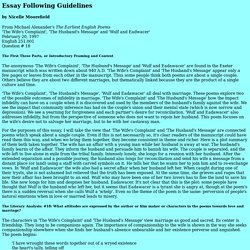
Thus some people think both poems are about a single couple. Anglo-Saxon literature - English and Related Literature, The University of York. Overview The poetry and prose of the Anglo-Saxons stands at the beginnings of English literature.
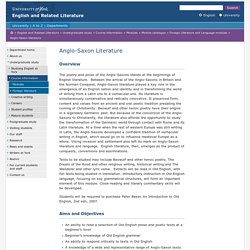
Between the arrival of the Anglo-Saxons in Britain and the Norman Conquest, Anglo-Saxon literature played a key role in the emergence of an English nation and identity and in transforming the world of writing from a Latin one to a vernacular one. Its literature is simultaneously conservative and radically innovative. It preserved form, content and values from an ancient and oral poetic tradition predating the coming of Christianity: Beowulf and other heroic poetry have their origins in a legendary Germanic past.
Exploring the Depth and Beauty of Anglo-Saxon Literature. This map shows kingdoms in the island of Great Britain at about the year 800 CE.

When we hear the words “Anglo-Saxon literature,” Beowulf is probably the first thing that comes to mind. Timeline of Anglo Saxon England 597 AD-687 AD. 597 - The Roman brand of Christianity is brought to Britain for the first time by St.

Augustine, the missionary sent from Pope Gregory to convert the Saxons. Augustine lands in Kent and is welcomed by King Aethelbert whose Frankish Queen is already a Christian practicing at her church of St. Martin's, Canterbury. Augustine converts Aethelbert and his court to Christianity and founds a monastery at Canterbury. The Anglo-Saxon kings > Alfred 'The Great'
Alfred 'The Great' (r. 871-899) Born at Wantage, Berkshire, in 849, Alfred was the fifth son of Aethelwulf, king of the West Saxons.
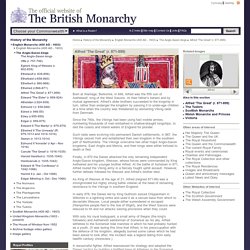
At their father's behest and by mutual agreement, Alfred's elder brothers succeeded to the kingship in turn, rather than endanger the kingdom by passing it to under-age children at a time when the country was threatened by worsening Viking raids from Denmark. Since the 790s, the Vikings had been using fast mobile armies, numbering thousands of men embarked in shallow-draught longships, to raid the coasts and inland waters of England for plunder. Such raids were evolving into permanent Danish settlements; in 867, the Vikings seized York and established their own kingdom in the southern part of Northumbria. The Vikings overcame two other major Anglo-Saxon kingdoms, East Anglia and Mercia, and their kings were either tortured to death or fled. Second, Alfred started a building programme of well-defended settlements across southern England. History - Ancient History in depth: Overview: Anglo-Saxons, 410 to 800. Anglo-Saxon Culture. Michael Delahoyde Washington State University History: When Rome was weakening early in the fifth century c.e., troops in the outlying regions, including the British Isles, were withdrawn.
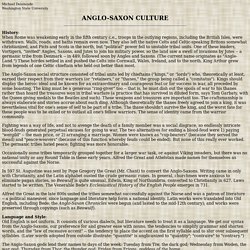
Walls, roads, and baths remain even now. They also left the native Celts and Celtic-speaking Britons somewhat christianized, and Picts and Scots in the north, but "political" power fell to unstable tribal units. One of these leaders, Vortigern, "invited" Angles, Saxons, and Jutes to join his military power, so the land saw a swell of invasions by Jutes -- a germanic tribe from Denmark -- in 449, followed soon by Angles and Saxons. (The current name originates as "Angle-Land. ") The Anglo-Saxon social structure consisted of tribal units led by chieftains ("kings," or "lords") who, theoretically at least, earned their respect from their warriors (or "retainers," or "thanes," the group being called a "comitatus").
In 597 St. Language and Style: Old English is not uniform. Works Consulted Mursell, Gordon. The Anglo-Saxon kings. In the Dark Ages during the fifth and sixth centuries, communities of peoples in Britain inhabited homelands with ill-defined borders.
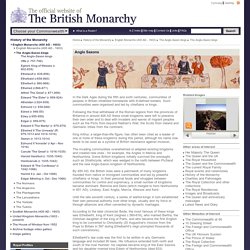
Such communities were organised and led by chieftains or kings. Following the final withdrawal of the Roman legions from the provinces of Britannia in around 408 AD these small kingdoms were left to preserve their own order and to deal with invaders and waves of migrant peoples such as the Picts from beyond Hadrian's Wall, the Scots from Ireland and Germanic tribes from the continent. King Arthur, a larger-than-life figure, has often been cited as a leader of one or more of these kingdoms during this period, although his name now tends to be used as a symbol of British resistance against invasion.
History - Ancient History in depth: The Anglo-Saxons. History - Ancient History in depth: The Anglo-Saxons. Lizbeth's MArtinezRoyal POrtfoilo - Home. Anglo-Saxon.